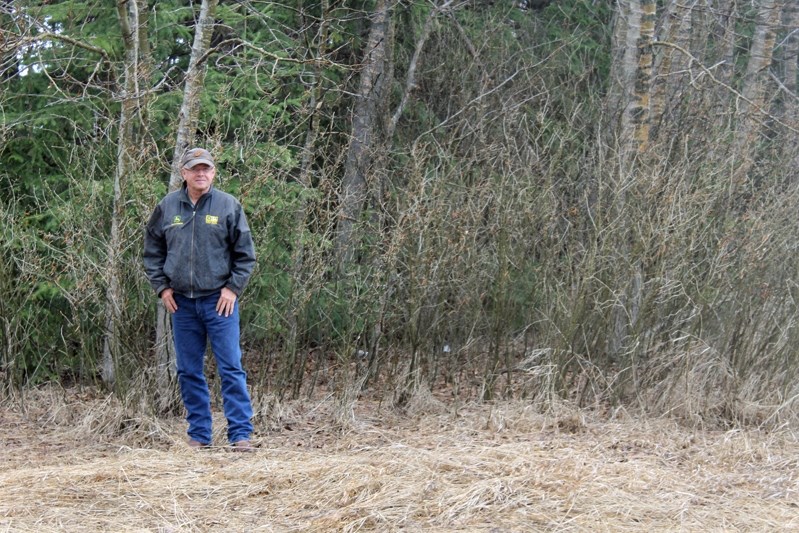Colin Kure stood outside his truck in the rain on the Highway 54 turnoff, scarcely a kilometre away from Spruce View, and pointed to a space between two copses of trees that were planted almost a century ago.
“The house was there, and the outbuildings were to my left in front of the trees,” said Kure, who then brought out a photo of an American Civil War powder flask, once owned by his grandfather Arthur.
“When Arthur came north from Illinois he brought this flask with him,” he said. “If you look closely, you can see how much wear is on the neck. I can't imagine how many people died because of this flask. My late wife's great-grandfather was also connected to the Civil War, but not as a soldier.”
There are all kinds of connections here at SE18-36-2 to the American Civil War. They also speak to a century of hard living and work that continues today on SE18-36-2.
The connections begin at the Innisfail Cemetery where in the back recesses a uniquely decorated headstone stands to mark the final resting place of American Civil War soldier and Dickson pioneer John P. Walters.
This story of John P. Walters spans almost 170 years, three families, three countries, and links Innisfail-area pioneers to the American Civil War not once, but twice.
Born in Sweden on March 21, 1844, Walters immigrated to the United States and lived in Nebraska before the beginning of the Civil War. Serving the North in the Grand Army of the Republic (GAR), he survived the conflict and settled in the small community of Newman Grove, Neb.
Walters, as a war veteran, became a founding member of the Emerick Post GAR No. 313 in Newman Grove in 1890. Just like the Royal Canadian Legion today, the organization served the social, economic and political needs of Civil War veterans. He eventually moved to Petersburg, Iowa until immigrating to Canada in 1902 to homestead in the Dickson area.
Walters became a cattle farmer. He married Abbie Bell Philip. The couple had a daughter named Wilma in 1888. While in Nebraska, Walters adopted a stepson, Everett Earl Snowdon, who moved to Canada with him. Walters passed away on April 17, 1916 but Snowden had already put his mark on the land 14 years earlier by homesteading one quarter south at SE18-36-2.
Like his stepfather, he raised cattle. He and his wife Stella had 10 children.
Snowdon ultimately moved to Innisfail in 1956, and passed away in 1958. That same year Colin Kure's father Elmer purchased Snowdon's land, know today as the Snowdon Quarter or SE18-36-2.
“According to local history books, Snowden's stepfather Walters homesteaded the quarter north of here, NE18-36-2, and Snowdon owned both after his father's passing in 1916,” said Kure.
The 69-year-old farmer said his grandfather Arthur farmed two quarters south of the Snowdon Quarter after buying it from Henry Larson in 1924.
“My grandfather emigrated from Illinois in 1924 and lived in the house that Larson built for a long time,” said Kure. “I have pictures of my father, his brothers and grandfather across the way sitting on the porch of the original home. I remember him telling me how my father used to catch jackrabbits and sell them to Jack Riley so he could feed his minks. My father and his dad both knew Snowdon.
“While clearing the quarter for my dad to straight grain farm in the late 1950s it was pretty obvious Snowdon worked pretty hard his entire life,” added Kure. “Cattle are hard work, not that straight grain farming isn't.”
Kure brought out a photo of the original farmyard, complete with outbuildings and house intact, comparing it to what the land looks like today.
“Over there in the corner you can see the original well,” said Kure. “The well still runs but someone stole the pump head and handle.”
Kure said his late wife Diana's ancestors helped build the Little Brown Church in the vale in Nashua, Iowa in 1862. After the Civil War her relatives returned to Nashua to complete the church, which was made famous through the popular hymn of the 1920s and '30s, The Church in the Wildwood.
While Civil War connections are strong on SE18-36-2, the Kure family has a long tradition of public service excellence and now boasts five generations of farming in the Dickson/Innisfail area.
“My father Elmer grew up across from the Snowdon Quarter and was a strong force in Alberta for environmental and habitat stewardship,” said Kure. “He learned from his father Art the basis of good farming practices, such as crop rotation. I learned so much from him and have continued his work with environmental issues and the oil industry near Sundre to protect our land resources.”
Today, a fifth generation Kure tends the fields at the Snowdon Quarter near Spruce View.
“Our family started their farming life on these fields, and my grandson Keegan proudly carries that tradition on,” said Kure. “From grandfather to grandson, we are now part of the land just as Earl Snowdon and his father, the enigmatic John P. Walters were.”



